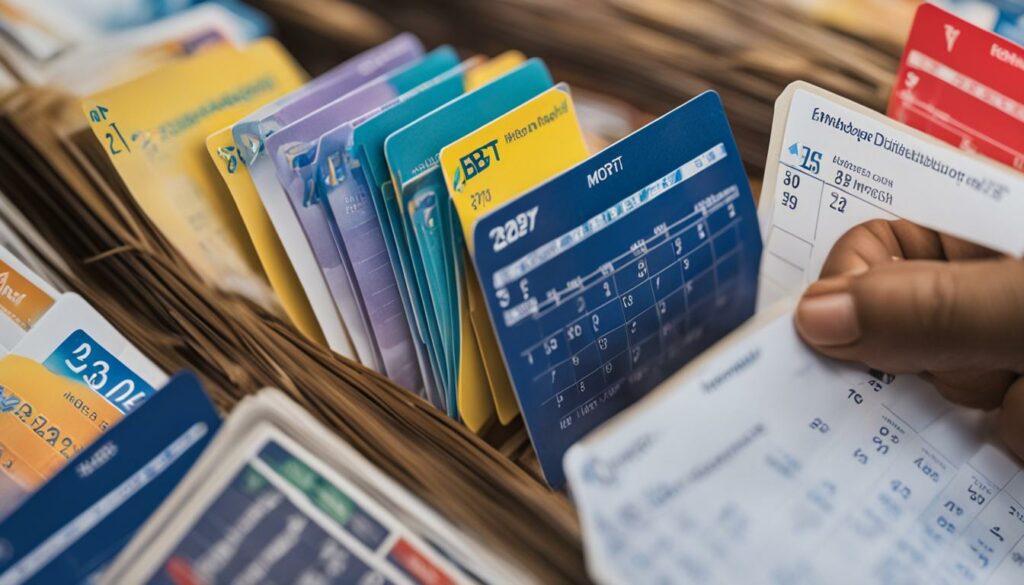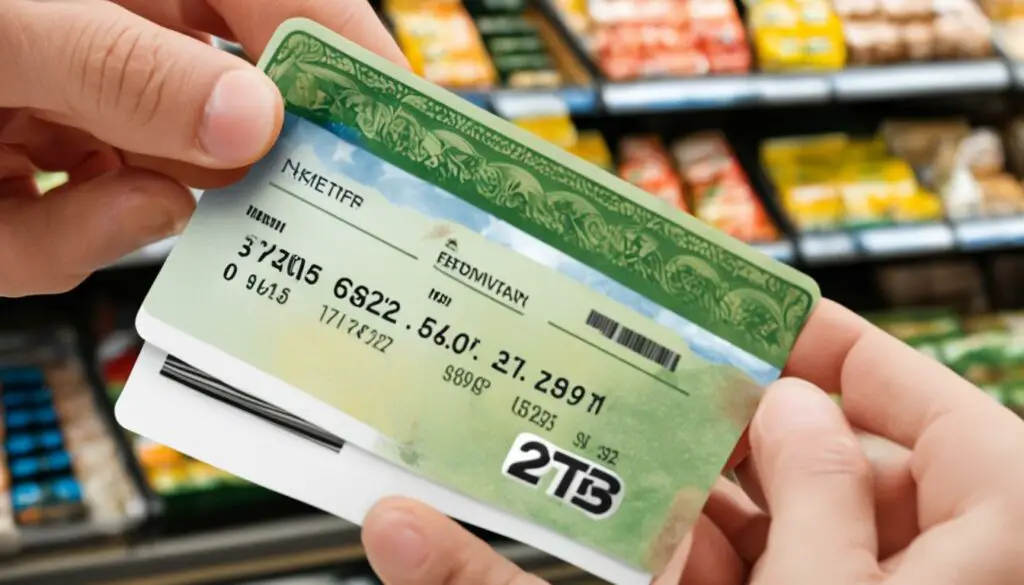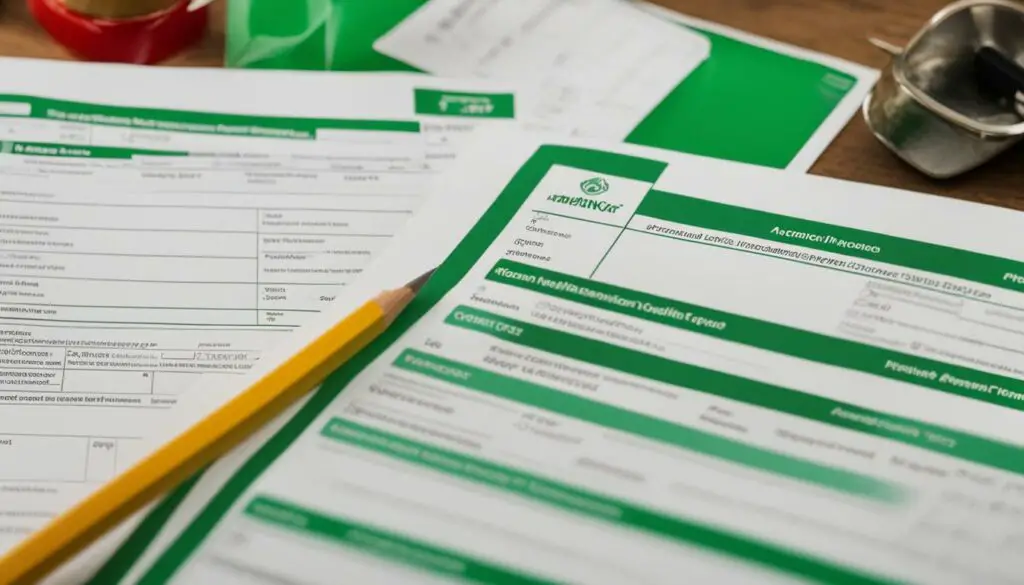Originally posted on December 20, 2023 @ 8:02 am
The P-EBT (Pandemic Electronic Benefit Transfer) program, administered by the U.S. Department of Agriculture (USDA), the California Department of Social Services (CDSS), and the California Department of Education (CDE), provides food benefits to eligible households of students who missed in-person school meals due to the COVID-19 pandemic.
The reload schedule for P-EBT benefits is based on various criteria, including free or reduced-price meal eligibility, attendance data, and participation in programs like the National School Lunch Program (NSLP) or School Breakfast Program (SBP).
Table of Contents
Key Takeaways:
- P-EBT is a federal program that provides food benefits to eligible households of students who missed in-person school meals due to COVID-19.
- The reload schedule for P-EBT benefits is based on criteria such as free or reduced-price meal eligibility and program participation.
- For the latest information on when P-EBT will reload, it is important to stay updated through official channels.
- Visit the official P-EBT website or contact the P-EBT Helpline for more information.
- Ensure that you use your P-EBT card within the specified timeframe and keep track of your P-EBT card balance.
P-EBT Eligibility Requirements for School Age Students

To qualify for P-EBT benefits, school age students must meet specific eligibility requirements. These requirements cover various aspects and criteria, including:
- Determination of eligibility for free or reduced-price meals in the current school year through a meal application, alternative income form, direct certification, or qualification as homeless, migrant, or foster.
- Students attending schools that participate in Provision 2 or the Community Eligibility Provision (CEP), regardless of individual student eligibility, are also eligible for P-EBT benefits.
- Students must have missed in-person instruction due to excused absences for five or more school days in a month.
- Students may also qualify if they were eligible for P-EBT benefits in the previous school year as a result of enrollment in independent study and continued attendance through independent study for five or more days in a month.
These requirements are designed to ensure that eligible students who experienced a loss of access to free or reduced-price meals due to COVID-19-related disruptions can receive the necessary food benefits through the P-EBT program.
It’s important for eligible households to understand and fulfill these requirements to ensure they receive the support they are entitled to. By meeting the eligibility criteria, students can access the benefits provided by the P-EBT program, helping families maintain food security during challenging times.
P-EBT Card Distribution and Reload Schedule

If you are eligible for P-EBT benefits, you will receive your P-EBT card without the need for an application. The California Department of Education (CDE) utilizes data from the California Longitudinal Pupil Achievement Data System (CALPADS) to identify eligible children. Attendance and independent study data collected from local education agencies (LEA) by the CDE determine the benefit level. Your P-EBT card will be mailed to the mailing address on file for the student. If the student does not have an address, the card will be sent to a designated school or district office.
The benefit period for SY 2022-23 P-EBT covers the period between August 1, 2022, and May 11, 2023. This means you will receive P-EBT benefits for this entire duration. Cards for summer P-EBT benefits are currently being processed and reloaded in August and September 2023. It is important to note that the benefit period and reload schedule may vary depending on the specific program and benefit period.
| Benefit Period | Reload Schedule |
|---|---|
| SY 2022-23 | August 2022 – May 2023 |
| Summer 2023 | August – September 2023 |
Expanded Eligibility for P-EBT Benefits

In the academic year 2022-23, the eligibility for P-EBT benefits has been expanded to include additional groups of students. This expansion aims to ensure that more students receive the necessary support to access nutritious meals. The expanded eligibility criteria now include:
- Students eligible for free or reduced-price meals who attend private and nonpublic participating schools
- Students enrolled in private virtual schools
- Students enrolled in virtual schools that do not participate in the National School Lunch Program (NSLP) or School Breakfast Program (SBP)
- Homeschooled children
This expansion means that students from a wider range of educational backgrounds can now qualify for P-EBT benefits, helping to alleviate food insecurity during the pandemic. The California Department of Education (CDE) will be in direct communication with these groups to inform them about their eligibility and the benefits they are entitled to.
“By expanding the eligibility for P-EBT benefits, we are striving to ensure that every child has access to nutritious meals, regardless of their school or educational setting. This initiative plays a crucial role in addressing food insecurity among students, especially during these challenging times.” – Jane Thompson, Education Advocate
Communication from the California Department of Education
The California Department of Education (CDE) recognizes the importance of clear and timely communication regarding P-EBT benefits. It is committed to reaching out to families and students who now meet the expanded eligibility criteria. The CDE will provide information on the application process, benefit distribution, and any additional requirements through various communication channels, including:
- Official letters or mailings
- Email notifications
- Updates on the CDE website
- Informational sessions or webinars
By proactively engaging with eligible households, the CDE aims to ensure that all students who qualify for P-EBT benefits are aware of their eligibility and can access the support they need.
Continue reading to learn more about the calculation of P-EBT benefit amounts and how the program has evolved over time.
Calculation of P-EBT Benefit Amounts
The amount of P-EBT benefits each student receives is calculated based on the daily rate of $8.18. This rate is multiplied by the number of days of excused absences or independent study attendance of five or more days in a month, as reported by local education agencies (LEA).
For example, if a student had 10 excused absences or attended independent study for 7 days in a month, the calculation would be: $8.18 x 10 days = $81.80.
The benefit coverage period for SY 2022-23 P-EBT extends from August 1, 2022, to May 11, 2023, ensuring that eligible students have access to food benefits throughout most of the school year.
It’s important to note that only students who had five or more absences or independent study days in a month will receive P-EBT benefits. This ensures that the program targets those who have experienced a significant impact on their access to school meals due to excused absences or independent study.
Summer 2023 P-EBT Benefits

In April 2023, the USDA approved the California Summer 2023 P-EBT plan, providing crucial food benefits to eligible households during the summer months. Currently, the California Department of Social Services (CDSS) is diligently processing and mailing Summer P-EBT benefits to qualified recipients.
If your household received a Summer P-EBT card, you’re in luck! Your SY 2022-23 P-EBT benefits will be reloaded onto your existing card during August and September 2023, ensuring a seamless continuation of support.
For graduated students who did not receive a Summer 2023 P-EBT card, don’t worry! You will receive a new P-EBT card specifically for the SY 2022-23 benefits. This card will be issued during August and September, guaranteeing that you receive the assistance you’re eligible for.
To learn more about Summer 2023 P-EBT and stay updated on the latest information, make sure to visit the CDSS website. They provide comprehensive resources to assist eligible households in maximizing the benefits and support available to them.
| Benefits | Reload Period |
|---|---|
| Summer P-EBT | Being processed and mailed |
| SY 2022-23 P-EBT for households with Summer P-EBT card | August and September 2023 |
| SY 2022-23 P-EBT for graduated students without Summer P-EBT card | August and September 2023 |
Resources and Communications for Eligible Households

The California Department of Social Services (CDSS) offers a range of resources and communications to support eligible households in staying informed about P-EBT benefits. They ensure that families have access to the information they need to make the most of the program.
Prior to the distribution of P-EBT cards, the CDSS sends postcards to eligible households through mail. These postcards serve as a helpful reminder of the availability of SY 2022-23 P-EBT benefits, ensuring that families are aware of the valuable support they can receive.
To make information accessible to a wider audience, the CDSS maintains an updated website with resources specifically tailored for eligible households and partners. These resources are available in multiple languages, making it easier for families from diverse backgrounds to access the information and support they need.
Additionally, the CDSS has established a dedicated P-EBT Helpline. This helpline is available to assist families with any card-related inquiries they may have, as well as answer general questions about individual eligibility and benefit amounts. The contact information for the P-EBT Helpline can be found on the CDSS website.
By providing these resources and communications, the CDSS ensures that eligible households have the necessary tools to navigate the P-EBT program effectively, making the most out of the benefits available to them.
P-EBT Resources:
- Postcards with important P-EBT information sent to eligible households
- Dedicated P-EBT website with resources for eligible households and partners, available in multiple languages
- P-EBT Helpline for card-related inquiries and general questions
P-EBT Card Expiration and Usage

As a P-EBT cardholder, it’s essential to stay informed about the expiration date and proper usage of your card. To ensure your benefits remain active, it’s crucial to use your P-EBT card at least once a year.
The P-EBT cards have an expiration period of one year from the date of the most recent transaction or, if no transactions were made, one year from the date of issuance. To avoid any inconvenience, it’s recommended that you make a purchase using your card within this timeframe.
The P-EBT card functions similarly to the CalFresh program, allowing you to buy eligible food items. Your P-EBT card is accepted at most grocery stores, farmer’s markets, and even online retailers, making it convenient for you to access nutritious food for your family.
To maximize your P-EBT benefits, be mindful of purchasing qualifying food items, which can include fruits, vegetables, meat, dairy products, and other essential groceries. Take advantage of the flexibility offered by your P-EBT card to make healthy choices for your household.
Remember, the minimum usage requirement is to utilize your P-EBT card once a year. By doing so, you can maintain the active status of your benefits and continue to access the support you need for your family’s well-being.
The Benefits of Regular Usage
Regularly using your P-EBT card not only helps prevent expiration but also offers other advantages. By consistently utilizing your benefits, you ensure that your family receives the full value of the support provided by the P-EBT program.
Moreover, frequent usage helps you stay connected with the P-EBT program, keeping you informed about any updates, changes, or additional resources that may become available. It also helps you maintain eligibility for future benefit cycles, ensuring continued assistance for your family’s food needs.
Make it a habit to review your P-EBT card balance regularly, so you can plan your grocery purchases accordingly. This way, you can take advantage of the full benefit amount and make the most of the assistance provided by the P-EBT program.
Application Process for P-EBT 4.0

Families who are eligible for P-EBT benefits do not need to go through a separate application process. The distribution of P-EBT cards is automated and based on the information provided by other programs, such as CalFresh Food benefits and free or reduced-price school meals. Eligible households will receive the P-EBT card without the need for additional paperwork.
To apply for free or reduced-price school meals, parents can contact their child’s school and complete the necessary application. Families can also apply for CalFresh Food benefits at GetCalfresh.org, which is a separate program that provides assistance for purchasing food.
However, school-aged children who did not attend a school that participated in the National School Lunch Program during the 2022-2023 school year may still be eligible for P-EBT 4.0 benefits. These children can apply for P-EBT benefits through GetPEBT.org between July 21, 2023, and August 15, 2023. The application process will involve verifying eligibility and providing the necessary documentation.
Eligibility Verification
To ensure the accuracy and eligibility of applicants for P-EBT 4.0 benefits, the verification process may include reviewing school records, attendance data, and other relevant information. It is important for applicants to provide complete and accurate details to expedite the verification process and prevent delays in receiving P-EBT benefits.
Applying for P-EBT Benefits
To apply for P-EBT benefits, eligible individuals can visit the GetPEBT.org website during the specified application period. The application will require providing personal information, such as the child’s name, date of birth, and school attendance details. Supporting documentation, such as school records or proof of enrollment, may also be required for verification purposes.
Once the application is submitted, it will be reviewed by the appropriate authorities to determine eligibility. If approved, the P-EBT benefits will be loaded onto the eligible household’s P-EBT card, which can be used for purchasing food items at authorized retailers.
| Application Process for P-EBT 4.0 |
|---|
| Families who are eligible for P-EBT benefits do not need to apply separately. |
| Parents can apply for free or reduced-price school meals through their child’s school. |
| Families can apply for CalFresh Food benefits at GetCalfresh.org. |
| Eligible school-aged children who did not participate in the National School Lunch Program during the 2022-2023 school year can apply for P-EBT 4.0 benefits through GetPEBT.org between July 21, 2023, and August 15, 2023. |
P-EBT Distribution for Young Children
For young children under 6 years old, P-EBT cards will be mailed beginning in August 2023 for those who were eligible from August to December 2022. Funds will be reloaded in September 2023 for those eligible from January to August 2023. New cards will be mailed in September 2023 for new cardholders who were eligible from August 2022 to May 2023. The distribution of P-EBT cards for young children follows an alphabetical order based on the eligible child’s first name.
P-EBT Distribution Schedule for Young Children:
| Eligibility Period | Card Mailing Date | Reload Date |
|---|---|---|
| August 2022 – December 2022 | August 2023 | N/A |
| January 2023 – August 2023 | September 2023 | September 2023 |
| August 2022 – May 2023 | September 2023 | September 2023 |
Note: The distribution of P-EBT cards is done alphabetically based on the eligible child’s first name to ensure a fair and organized process.
P-EBT Program History and Previous Card Distribution
The P-EBT (Pandemic Electronic Benefit Transfer) program has undergone several iterations, including P-EBT 1.0, P-EBT 2.0, and P-EBT 3.0. Each version of the program targeted specific groups of eligible children based on their free or reduced-price meal eligibility and participation in school meal programs.
Previous card distributions were automatically mailed to eligible families, ensuring that the benefits reached those in need. The amount of benefits varied depending on the specific program version and the benefit period covered.
Conclusion
In summary, the P-EBT (Pandemic Electronic Benefit Transfer) program offers essential food benefits to eligible households impacted by the COVID-19 pandemic. Eligibility for P-EBT benefits and the reload schedule are determined by criteria such as free or reduced-price meal eligibility, attendance data, and participation in meal programs. The program automatically issues P-EBT cards to eligible households, eliminating the need for families to apply.
To avoid card expiration, it is crucial for families to use their P-EBT cards at least once a year. The P-EBT program has undergone several versions and benefit periods, adapting to changing needs. Its main objective is to alleviate the financial strain caused by the pandemic and provide continuous nutritional support for children.
By supporting eligible households and ensuring access to nutritious food, the P-EBT program contributes to the overall well-being of families affected by the pandemic. As the situation continues to evolve, the program remains an important resource for families in need.
FAQ
When does P-EBT reload?
The reload schedule for P-EBT benefits varies depending on the benefit period. For the SY 2022-23 benefits, cards for eligible households will be reloaded in August and September 2023. Summer P-EBT benefits for 2023 are also being processed and reloaded during this time.
What are the eligibility requirements for school-age students to qualify for P-EBT benefits?
School-age students must meet several eligibility requirements, including being determined eligible for free or reduced-price meals through a meal application, alternative income form, direct certification, or qualification as homeless, migrant, or foster. Students who attend schools participating in Provision 2 or the Community Eligibility Provision (CEP) are also eligible. They must have missed in-person instruction through excused absences for five or more school days in a month or be eligible for P-EBT in the previous school year due to enrollment in independent study and continued attendance through independent study for five or more days in a month.
What is the distribution and reload schedule for P-EBT cards?
P-EBT cards are automatically issued to eligible households without the need for an application. The cards are mailed to the student’s mailing address or a designated school or district office if the student doesn’t have an address. For the SY 2022-23 benefits, cards for eligible households will be reloaded in August and September 2023. The distribution of P-EBT cards for young children follows an alphabetical order based on the eligible child’s first name.
Who is eligible for expanded P-EBT benefits?
In SY 2022-23, the eligibility for P-EBT benefits has been expanded to include additional groups of students, such as those eligible for free or reduced-price meals who attend private and nonpublic participating schools, private virtual schools, virtual schools that do not participate in the National School Lunch Program or School Breakfast Program, and homeschooled children. The California Department of Education will provide separate communication to these groups regarding their eligibility and benefits.
How are P-EBT benefit amounts calculated?
P-EBT benefits are calculated based on the daily rate of $8.18. This rate is multiplied by the number of days of excused absences or independent study attendance of five or more days in a month, as reported by local education agencies. Only students who had five or more absences or independent study days in a month will receive benefits.
What is the status of Summer 2023 P-EBT benefits?
Summer P-EBT benefits for 2023 have been approved by the USDA. The benefits are currently being processed and mailed to eligible households. Families that received Summer P-EBT cards will have their SY 2022-23 benefits reloaded onto those existing cards in August and September 2023. Graduated students who did not receive a Summer 2023 P-EBT card will receive a new card with only the SY 2022-23 benefits during August and September.
Where can eligible households find resources and information about P-EBT benefits?
The California Department of Social Services provides resources and communications to eligible households. They send postcards in the mail prior to card distribution, update their website with resources in multiple languages, and have a dedicated P-EBT Helpline for inquiries and questions. The contact information for the P-EBT Helpline can be found on the CDSS website.
What is the expiration and usage requirement for P-EBT cards?
P-EBT cards must be used at least once a year to prevent them from expiring. The cards expire one year from the date of the most recent transaction or one year from the date of issuance if no transactions were made. P-EBT cards can be used like CalFresh to buy food and are accepted at most grocery stores, farmer’s markets, and online retailers.
How can families apply for P-EBT 4.0?
Families whose school-aged children did not attend a school participating in the National School Lunch Program during the 2022-2023 school year may still be eligible for P-EBT 4.0. They can apply for benefits through the GetPEBT.org website between July 21, 2023, and August 15, 2023. The application process involves eligibility verification.
What is the distribution schedule for P-EBT benefits for young children?
For young children under 6 years old, P-EBT cards will be mailed beginning in August 2023 for those who were eligible from August to December 2022. Funds will be reloaded in September 2023 for those eligible from January to August 2023. New cards will be mailed in September 2023 for newly eligible young children from August 2022 to May 2023.
What is the history of the P-EBT program?
The P-EBT program has gone through multiple iterations, including P-EBT 1.0, P-EBT 2.0, and P-EBT 3.0, targeting specific groups of eligible children based on free or reduced-price meal eligibility and participation in school meal programs. Previous card distributions were automatically mailed to eligible families, and the benefit amounts varied depending on the program version and benefit period.
Source Links
- https://www.marca.com/en/lifestyle/us-news/personal-finance/2022/11/23/637de0e922601dad3c8b457c.html
- https://www.icarol.info/ResourceView2.aspx?org=2271&agencynum=70157829
- https://www.cde.ca.gov/ls/nu/sy2023pebtprtgpubschls.asp
See also:
Leave a Reply